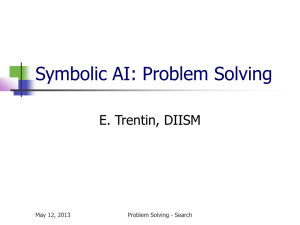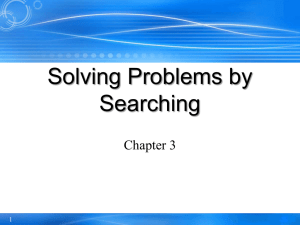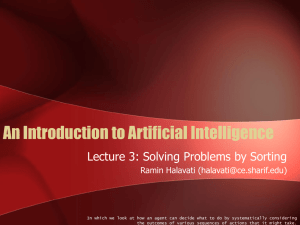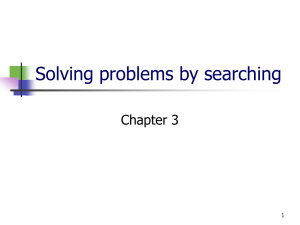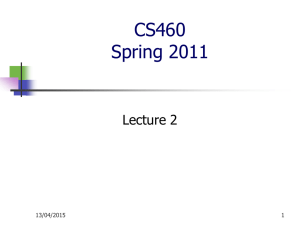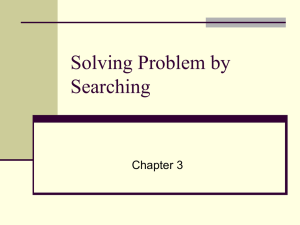Ch.3 Solving Problems by Searching
advertisement
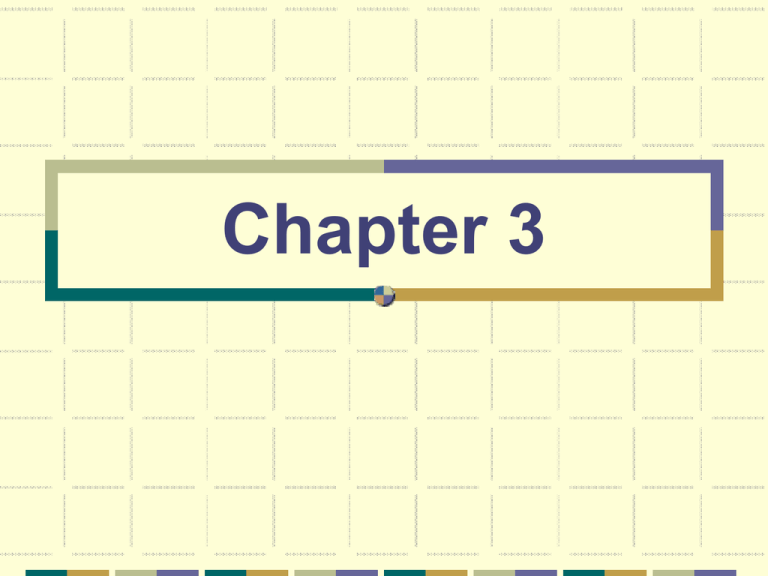
Chapter 3
Solving Problems by Searching
Reflex agent is simple
base their actions on
a direct mapping from states to actions
but cannot work well in environments
which this mapping would be too large to store
and would take too long to learn
Hence, goal-based agent is used
Problem-solving agent
Problem-solving agent
A kind of goal-based agent
It solves problem by
finding sequences of actions that lead to
desirable states (goals)
To solve a problem,
the first step is the goal formulation, based on
the current situation
Goal formulation
The goal is formulated
as a set of world states, in which the goal is
satisfied
Reaching from initial state goal state
Actions are required
Actions are the operators
causing transitions between world states
Actions should be abstract enough at a
certain degree, instead of very detailed
E.g., turn left VS turn left 30 degree, etc.
Problem formulation
The process of deciding
what actions and states to consider
E.g., driving Amman Zarqa
in-between states and actions defined
States: Some places in Amman & Zarqa
Actions: Turn left, Turn right, go straight,
accelerate & brake, etc.
Search
Because there are many ways to achieve
the same goal
Those ways are together expressed as a tree
Multiple options of unknown value at a point,
the agent can examine different possible
sequences of actions, and choose the best
This process of looking for the best sequence
is called search
The best sequence is then a list of actions,
called solution
Search algorithm
Defined as
taking a problem
and returns a solution
Once a solution is found
the agent follows the solution
and carries out the list of actions –
execution phase
Design of an agent
“Formulate, search, execute”
Well-defined problems and solutions
A problem is defined by 5 components:
Initial state
Actions
Transition model or
(Successor functions)
Goal Test.
Path Cost.
Well-defined problems and solutions
A problem is defined by 4 components:
The initial state
that the agent starts in
The set of possible actions
Transition model: description of what each action
does.
(successor functions): refer to any atate reachable
from given state by a single action
Initial state, actions and Transition model define the
state space
the set of all states reachable from the initial state by any
sequence of actions.
A path in the state space:
any sequence of states connected by a sequence of actions.
Well-defined problems and solutions
The goal test
Applied to the current state to test
if the agent is in its goal
-Sometimes there is an explicit set of possible goal states.
(example: in(Amman).
-Sometimes the goal is described by the properties
instead of stating explicitly the set of states
Example: Chess
the agent wins if it can capture the KING of the opponent on
next move ( checkmate).
no matter what the opponent does
Well-defined problems and solutions
A path cost function,
assigns a numeric cost to each path
= performance measure
denoted by g
to distinguish the best path from others
Usually the path cost is
the sum of the step costs of the individual
actions (in the action list)
Well-defined problems and solutions
Together a problem is defined by
Initial state
Actions
Successor function
Goal test
Path cost function
The solution of a problem is then
a path from the initial state to a state satisfying the goal
test
Optimal solution
the solution with lowest path cost among all solutions
Formulating problems
Besides the four components for problem
formulation
anything else?
Abstraction
the process to take out the irrelevant information
leave the most essential parts to the description of the
states
( Remove detail from representation)
Conclusion: Only the most important parts that are
contributing to searching are used
Evaluation Criteria
formulation of a problem as search task
basic search strategies
important properties of search
strategies
selection of search strategies for
specific tasks
(The ordering of the nodes in FRINGE
defines the search strategy)
Problem-Solving Agents
agents whose task it is to solve a particular
problem(steps)
goal formulation
what is the goal state
what are important characteristics of the goal state
how does the agent know that it has reached the goal
are there several possible goal states
are they equal or are some more preferable
problem formulation
what are the possible states of the world relevant for solving
the problem
what information is accessible to the agent
how can the agent progress from state to state
Example
From our Example
1. Formulate Goal
- Be In Amman
2. Formulate Problem
- States : Cities
- actions : Drive Between Cities
3. Find Solution
- Sequence of Cities : ajlun – Jarash - Amman
Our Example
1. Problem : To Go from Ajlun to Amman
2. Initial State : Ajlween
3. Operator : Go from One City To another .
4. State Space : {Jarash , Salat , irbed,……..}
5. Goal Test : are the agent in Amman.
6. Path Cost Function : Get The Cost From The Map.
7. Solution :
{
{Aj Ja Ir Ma Za Am} , {Aj Ir Ma Za Am} …. {Aj Ja Am}
8. State Set Space : {Ajlun Jarash Amman}
}
Example: Romania
On holiday in Romania; currently in Arad.
Flight leaves tomorrow from Bucharest
Formulate goal:
be in Bucharest
Formulate problem:
states: various cities
actions: drive between cities
Find solution:
sequence of cities, e.g., Arad, Sibiu, Fagaras,
Bucharest
Example: Romania
Single-state problem formulation
A problem is defined by four items:
1.
initial state e.g., "at Arad"
2.
2.
actions or successor function S(x) = set of action–state pairs
e.g., S(Arad) = {<Arad Zerind, Zerind>, … }
3.
goal test, can be
explicit, e.g., x = "at Bucharest"
implicit, e.g., Checkmate(x)
4.
path cost (additive)
e.g., sum of distances, number of actions executed, etc.
c(x,a,y) is the step cost, assumed to be ≥ 0
Example problems
Toy problems
those intended to illustrate or exercise
various problem-solving methods
E.g., puzzle, chess, etc.
Real-world problems
tend to be more difficult and whose
solutions people actually care about
E.g., Design, planning, etc.
Toy problems
Example: vacuum world
Number of states: 8
Initial state: Any
Number of actions: 4
left, right, suck,
noOp
Goal: clean up all dirt
Goal states: {7, 8}
Path Cost:
Each step costs 1
The 8-puzzle
The 8-puzzle
States:
a state description specifies the location of each of
the eight tiles and blank in one of the nine squares
Initial State:
Any state in state space
Successor function:
the blank moves Left, Right, Up, or Down
Goal test:
current state matches the goal configuration
Path cost:
each step costs 1, so the path cost is just the length
of the path
The 8-queens
There are two ways to formulate the
problem
All of them have the common followings:
Goal test: 8 queens on board, not attacking
to each other
Path cost: zero
The 8-queens
(1) Incremental formulation
involves operators that augment the state
description starting from an empty state
Each action adds a queen to the state
States:
any arrangement of 0 to 8 queens on board
Successor function:
add a queen to any empty square
The 8-queens
(2) Complete-state formulation
starts with all 8 queens on the board
move the queens individually around
States:
any arrangement of 8 queens, one per column in
the leftmost columns
Operators: move an attacked queen to a row,
not attacked by any other
The 8-queens
Conclusion:
the right formulation makes a big difference
to the size of the search space
Example: River Crossing
Items: Man, Wolf, Corn, Chicken.
Man wants to cross river with all items.
Wolf will eat Chicken
Chicken will eat corn.
Boat will take max of two.
3.3 Searching for solutions
3.3 Searching for solutions
Finding out a solution is done by
searching through the state space
All problems are transformed
as a search tree
generated by the initial state and
successor function
Search tree
Initial state
The root of the search tree is a search node
Expanding
applying successor function to the current state
thereby generating a new set of states
leaf nodes
the states having no successors
Fringe : Set of search nodes that have not been
expanded yet.
Refer to next figure
Tree search example
Tree search example
Search tree
The essence of searching
in case the first choice is not correct
choosing one option and keep others for later
inspection
Hence we have the search strategy
which determines the choice of which state to
expand
good choice fewer work faster
Important:
state space ≠ search tree
Search tree
State space
has unique states {A, B}
while a search tree may have cyclic paths:
A-B-A-B-A-B- …
A good search strategy should avoid
such paths
Search tree
A node is having five components:
STATE: which state it is in the state space
PARENT-NODE: from which node it is generated
ACTION: which action applied to its parent-node
to generate it
PATH-COST: the cost, g(n), from initial state to
the node n itself
DEPTH: number of steps along the path from the
initial state
Measuring problem-solving performance
The evaluation of a search strategy
Completeness:
Optimality:
does the strategy find the highest-quality solution
when there are several different solutions?
Time complexity:
is the strategy guaranteed to find a solution when
there is one?
how long does it take to find a solution?
Space complexity:
how much memory is needed to perform the search?
Measuring problem-solving performance
In AI, complexity is expressed in
b, branching factor, maximum number of
successors of any node
d, the depth of the shallowest goal node.
(depth of the least-cost solution)
m, the maximum length of any path in the state
space
Time and Space is measured in
number of nodes generated during the search
maximum number of nodes stored in memory
Measuring problem-solving performance
For effectiveness of a search algorithm
we can just consider the total cost
The total cost = path cost (g)of the solution
found + search cost
search cost = time necessary to find the solution
Tradeoff:
(long time, optimal solution with least g)
vs. (shorter time, solution with slightly larger
path cost g)
3.4 Uninformed search strategies
3.4 Uninformed search strategies
Uninformed search
no information about the number of steps
or the path cost from the current state to
the goal
search the state space blindly
Informed search, or heuristic search
a cleverer strategy that searches toward
the goal,
based on the information from the current
state so far
Uninformed search strategies
Breadth-first search
Uniform cost search
Depth-first search
Depth-limited search
Iterative deepening search
Bidirectional search
Breadth-first search
The root node is expanded first (FIFO)
All the nodes generated by the root
node are then expanded
And then their successors and so on
Breath-first search
S
A
B
C
11
D
D
E
D F
14
G
19
A
E
B
F
C
19
G
17
E
B
C
17
B
E
F
A C
15 15
F
G 25
G
13
Breadth-First Strategy
New nodes are inserted at the end of FRINGE
1
2
4
FRINGE = (1)
3
5
6
7
Breadth-First Strategy
New nodes are inserted at the end of FRINGE
1
2
4
FRINGE = (2, 3)
3
5
6
7
Breadth-First Strategy
New nodes are inserted at the end of FRINGE
1
2
4
FRINGE = (3, 4, 5)
3
5
6
7
Breadth-First Strategy
New nodes are inserted at the end of FRINGE
1
2
4
FRINGE = (4, 5, 6, 7)
3
5
6
7
Breadth-first search (Analysis)
Breadth-first search
Complete – find the solution eventually
Optimal, if step cost is 1
The disadvantage
if the branching factor of a node is large,
for even small instances (e.g., chess)
the space complexity and the time complexity
are enormous
Properties of breadth-first search
Complete? Yes (if b is finite)
Time? 1+b+b2+b3+… +bd + b(bd-1) = O(bd+1)
Space? O(bd+1) (keeps every node in
memory)
Optimal? Yes (if cost = 1 per step)
Breadth-first search (Analysis)
assuming 10000 nodes can be processed per second, each with
1000 bytes of storage
Uniform cost search
Breadth-first finds the shallowest goal state
but not necessarily be the least-cost solution
work only if all step costs are equal
Uniform cost search
modifies breadth-first strategy
by always expanding the lowest-cost node
The lowest-cost node is measured by the path
cost g(n)
Uniform cost search
the first found solution is guaranteed to be the cheapest
least in depth
But restrict to non-decreasing path cost
Unsuitable for operators with negative cost
Uniform-cost search
Expand least-cost unexpanded node
Implementation:
fringe = queue ordered by path cost
Equivalent to breadth-first if step costs all equal
Complete? Yes, if step cost ≥ ε
Time? # of nodes with g ≤ cost of optimal solution,
O(bceiling(C*/ ε)) where C* is the cost of the optimal
solution
Space? # of nodes with g ≤ cost of optimal solution,
O(bceiling(C*/ ε))
Depth-first search
Always expands one of the nodes at the
deepest level of the tree
Only when the search hits a dead end
goes back and expands nodes at shallower levels
Dead end leaf nodes but not the goal
Backtracking search
only one successor is generated on expansion
rather than all successors
fewer memory
Depth-first search
Expand deepest unexpanded node
Implementation:
fringe = LIFO queue, i.e., put successors at front
Depth-first search
Expand deepest unexpanded node
Implementation:
fringe = LIFO queue, i.e., put successors at front
Depth-first search
Expand deepest unexpanded node
Implementation:
fringe = LIFO queue, i.e., put successors at front
Depth-first search
Expand deepest unexpanded node
Implementation:
fringe = LIFO queue, i.e., put successors at front
Depth-first search
Expand deepest unexpanded node
Implementation:
fringe = LIFO queue, i.e., put successors at front
Depth-first search
Expand deepest unexpanded node
Implementation:
fringe = LIFO queue, i.e., put successors at front
Depth-first search
Expand deepest unexpanded node
Implementation:
fringe = LIFO queue, i.e., put successors at front
Depth-first search
Expand deepest unexpanded node
Implementation:
fringe = LIFO queue, i.e., put successors at front
Depth-first search
Expand deepest unexpanded node
Implementation:
fringe = LIFO queue, i.e., put successors at front
Depth-first search
Expand deepest unexpanded node
Implementation:
fringe = LIFO queue, i.e., put successors at front
Depth-first search
Expand deepest unexpanded node
Implementation:
fringe = LIFO queue, i.e., put successors at front
Depth-first search
Expand deepest unexpanded node
Implementation:
fringe = LIFO queue, i.e., put successors at front
Depth-first search
S
A
B
C
11
D
14
D
D
E
A
E
F
B
F
G
19
C
19
G
17
E
B
C
17
B
E
A
15
F
G 25
F
C G
15 13
Depth-first search (Analysis)
Not complete
because a path may be infinite or looping
then the path will never fail and go back try
another option
Not optimal
it doesn't guarantee the best solution
It overcomes
the time and space complexities
Properties of depth-first search
Complete? No: fails in infinite-depth spaces,
spaces with loops
Modify to avoid repeated states along path
complete in finite spaces
Time? O(bm): terrible if m is much larger than
d
but if solutions are dense, may be much faster
than breadth-first
Space? O(bm), i.e., linear space!
Depth-Limited Strategy
Depth-first with depth cutoff k (maximal
depth below which nodes are not
expanded)
Three possible outcomes:
Solution
Failure (no solution)
Cutoff (no solution within cutoff)
Depth-limited search
It is depth-first search
with a predefined maximum depth
However, it is usually not easy to define the
suitable maximum depth
too small no solution can be found
too large the same problems are
suffered from
Anyway the search is
complete
but still not optimal
Depth-limited
search
S
depth = 3
A
3
D
6
B
C
11
D
E
D F
14
G
19
A
E
B
F
C
19
G
17
E
B
C
17
B
E
F
A C
15 15
F
G 25
G
13
Iterative deepening search
No choosing of the best depth limit
It tries all possible depth limits:
first 0, then 1, 2, and so on
combines the benefits of depth-first and
breadth-first search
Iterative deepening search
Iterative deepening search
(Analysis)
optimal
complete
Time and space complexities
reasonable
suitable for the problem
having a large search space
and the depth of the solution is not known
Properties of iterative deepening
search
Complete? Yes
Time? (d+1)b0 + d b1 + (d-1)b2 + … + bd
= O(bd)
Space? O(bd)
Optimal? Yes, if step cost = 1
Iterative lengthening search
IDS is using depth as limit
ILS is using path cost as limit
an iterative version for uniform cost search
has the advantages of uniform cost search
while avoiding its memory requirements
but ILS incurs substantial overhead
compared to uniform cost search
Bidirectional search
Run two simultaneous searches
one forward from the initial state another
backward from the goal
stop when the two searches meet
However, computing backward is difficult
A huge amount of goal states
at the goal state, which actions are used to
compute it?
can the actions be reversible to computer its
predecessors?
Bidirectional Strategy
2 fringe queues: FRINGE1 and FRINGE2
Time and space complexity = O(bd/2) << O(bd)
Bidirectional
search
S
A
B
C
11
D
D
E
D F
14
G
19
Forward
Backwards
A
E
B
F
C
19
G
17
E
B
C
17
B
E
F
A C
15 15
F
G 25
G
13
Comparing search strategies
Avoiding repeated states
for all search strategies
There is possibility of expanding states
that have already been encountered and expanded
before, on some other path
may cause the path to be infinite loop forever
Algorithms that forget their history
are doomed to repeat it
Avoiding repeated states
Three ways to deal with this possibility
Do not return to the state it just came from
Do not create paths with cycles
Refuse generation of any successor same as its
parent state
Refuse generation of any successor same as its
ancestor states
Do not generate any generated state
Not only its ancestor states, but also all other
expanded states have to be checked against
Avoiding repeated states
We then define a data structure
closed list:
a set storing every expanded node so far
If the current node matches a node on the
closed list, discard it.

